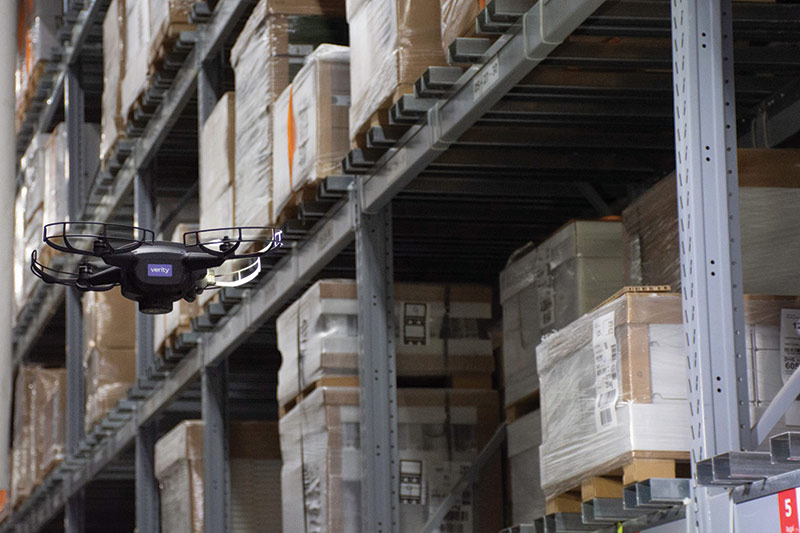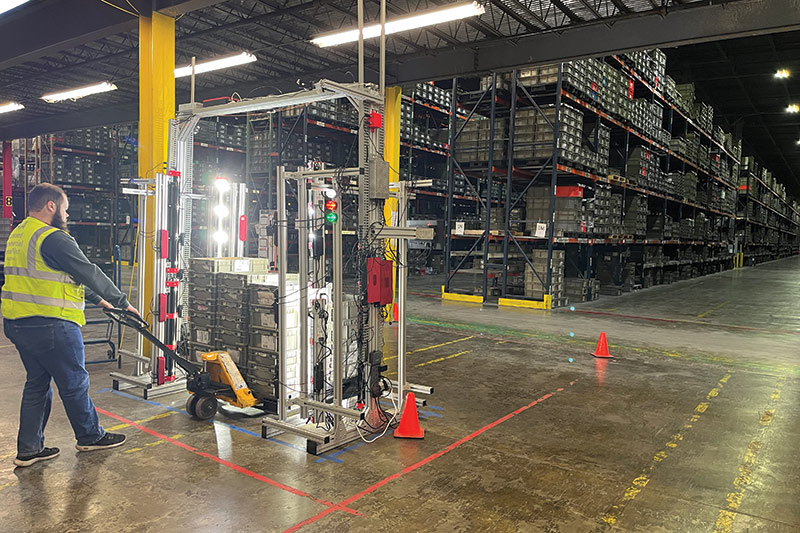Three keys to next-level inventory control
The last couple of years have been tumultuous for supply chains, with inventory control tending to suffer. But operations can regain control over inventory accuracy and planning, and perhaps enhance it, through methods and technologies that include computer vision, WMS upgrades and a newer generation of AI-based planning solutions.

Inventory and labor have a way of keeping DC managers worried. With labor, it starts with having enough people to get orders out the door on time. With inventory, it revolves around having enough of the right items in forward pick areas to hit service levels without carrying too much inventory.
Add in the supply chain turbulence the last couple of years, and inventory is top of mind. For instance, Modern’s recent DC operations trend study found supply chain disruption was the leading industry issue of concern, topping even labor availability, which had led the last several years.
Inventory management is critical, but no single technology will guarantee best-in-class inventory management. Automated storage and retrieval system (AS/RS) solutions manage inventory tightly while triggering replenishment for its zone, but not every warehouse can justify an AS/RS.
The good news is multiple technologies contribute to improved inventory management, from warehouse management system (WMS) upgrades, to updated e devices for associates, to the evolution of planning solutions based on artificial intelligence (AI), as well as new solutions such as inventory-counting drones and vision. Here are three developments that could help many operations.
1.) AI-based planning
During the pandemic, we saw wild swings in both demand and supply, leading a “perfect storm” that negatively impacted inventory management for many companies, says P.K. Prasanna, vice president of global industry solutions for Bristlecone, a consultancy that helps deploy planning solutions.
Generally, the inventory planning processes that fell short during the pandemic were not a shortcoming of newer planning software itself, Prasanna says, but rather, the business assumptions behind how the software was configured and used just didn’t hold true under the major swings in demand and supply that took place.
“I think most of us in industry had more or less assumed a frictionless sort of a model where you could get things from any place you wanted in time to build a product or get it to market and that particular set of assumptions turned out to be pretty seriously shattered during Covid,” Prasanna says. “Much of the problem was that the assumptions being made around the models were fundamentally made for, if not a totally ‘sunny day’ scenario, certainly less than the ‘perfect storm’ scenario we ended up having. Secondarily, many companies were not on newer solutions, they were still operating with spreadsheets, and that made it really hard for them to pivot to changing conditions across different processes.”

Newer planning solutions, however, can help enterprises create better plans because they can use AI to optimize based on a variety of internal and external inputs, and thus better factor risk into plans, and refine plans rapidly as new data comes in, Prasanna adds.
“A lot of the solution vendors as well as services companies are pivoting toward solutions that are better able to anticipate and predict risk, and this is where AI capabilities really help,” he says.
Different types of planning solutions can help with inventory management, adds Prasanna, including DC network optimization solutions that determine where to locate DCs and inventory over the long-term, as well as more niche solutions that make more tactical recommendations.
“We’re seeing a lot of specialty planning providers starting to add some intelligence and AI capabilities for specific use cases, such as inventory optimization where you can use AI tools connected to the planning processes, and the AI essentially presents a set of capabilities to the supply chain team that says, ‘if you’re trying to decide on a certain level of safety stock, here’s what we recommend,’” Prasanna says. “Overall, we’re evolving to intelligent, autonomous planning solutions that are better able to detect risks.”
Inventory planning tools need accurate visibility into inventory levels held at internal or external locations to be as effective as possible, says Felix Vicknair, vice president of supply chain solutions at Kenco Group, a leading 3PL.
Solutions that plan for inventory across different levels in a value chain, known as multi-echelon inventory optimization (MEIO) solutions, can help in some cases, Vicknair adds. “MEIO is a larger view or consideration for inventory decisions, while ‘inventory optimization’ itself may only consider a single node or point within a supply chain,” explains Vicknair.
2.) Put vision to work
While bar code data scans as part of WMS workflows and serves as a foundation for inventory accuracy in DCs, some DCs are also starting to use machine vision-enabled solutions that don’t require a human-triggered scan to capture data and that do more than capture data on bar codes.
Computer vision and AI can be applied at key points in DCs to count, process and track inventory autonomously, says S.K. “KG” Ganapathi, CEO and founder of Vimaan, which offers a computer vision solution for warehouse inventory management.
Importantly, says Ganapathi, the vision technology not only captures bar code data, but because the vision hardware is integrated with Vimaan’s AI software layer, it can instantly capture dimensional measures, or detect condition issues with cartons or labels. That makes receiving a natural DC process for Vimaan’s solution because exceptions detected at receiving can be remedied before service levels are impacted, with images and data to support claims processing with suppliers.
“Our technology can fit into multiple existing workflows, including receiving,” Ganapathi says. “No. 1, you automate that [data capture and verification] process, and No. 2, it provides you with a significantly enhanced degree of visibility and traceability into what you receive or whatever other workflows you are executing.”
For a pallet receiving workflow, Vimaan’s vision system can be set up portal-style where a lift truck moving a pallet load into a staging area can simply pass through the vision system with its load without pausing. This can save time versus a receiving process where an operator has to pause and capture bar code data, dimension pallets and inspect for damages—which can be time-consuming with mixed-SKU pallets. Vision can also capture human readable text such as dates, lots and destinations that typically need manual confirmation.
In pallet receiving, it can measure the dimensions of the unitized load and can detect if a carton on the pallet does not have a bar code associated with it or spot issues like damaged labels.
Vimaan also has a solution configured to capture data from parcels as they are inducted onto a conveyor, or for other workflows in a warehouse, such as packing and shipping. Vimaan, founded in 2017, has its solution deployed at companies including Sunland Logistics Solutions, where it is used in receiving and shipping areas.
The solution’s database can integrate with and update a WMS, so at the end of the day, you get less of a time lag between what a WMS thinks it knows about inventory, and what has actually been received, processed or shipped by an operation. In this sense, says Ganapathi, vision and AI are taking data capture into an era in the physical world receiving and processing goods can be almost instantly reflected in systems like WMS.
“When you have processes like receiving, there historically has been this time gap between the physical receipt of something and the systemic receipt of something,” Ganapathi says. “It’s like a no-man’s land, where our technology compresses to next to nothing, because now instead of taking four hours to unload a truck and properly validate what was received, with our system, you’re doing it in an hour or less. In pallet receiving, our users have gone from three to five minutes per pallet to validate what was received, to receiving three pallets per minute into their system. That is the kind of difference this technology can make in receiving.”
Self-flying drones that can read bar codes on pallets are another emerging technology being applied to inventory control. By using camera-based imaging on a self-flying drone, an operation can achieve a high level of accuracy and eliminate manual data capture tasks in that zone, according to Raffaello D’Andrea, founder and CEO of drone system provider Verity.
“Counting palleted inventory in large warehouses is a universally detested task,” says D’Andrea. “In addition to alleviating labor constraints, automated inventory management supports much more frequent scanning, allowing errors to be found far more frequently and before they impact the bottom line. In some cases, our clients are scanning 50x more frequently and seeing a tenfold reduction in errors.”
The updated view of what is in the racks carries benefits like fewer surprise stock outs, but also enhances productivity, adds D’Andrea, largely because forklift drivers and staff are not wasting time searching for lost and misplaced pallets, or conducting verification checks for low-stock inventory. He advises, however, that drones are ideally suited to single-deep storage, though it can provide value for deeper storage configurations as well.
“Like humans, the drones are limited by their scope of vision, making them ideal for single-deep pallets stored in high-bay racking. In cases where pallets are stored two or three deep, manual counting is needed to augment the automated count.”
3.) Enhance WMS
For all the attention on emerging technologies as a route to better inventory management, when you examine the typical system footprint, WMS is what governs inventory. That makes an effective WMS table stakes for inventory accuracy in DCs, notes Howard Turner, director of supply chain systems at consulting firm St. Onge Company.
“The positive impact a WMS can have on inventory is a bit overlooked these days, because WMS is so widely used, but WMS still has a critical role to play,” Turner says. “WMS is the system of record for inventory, so even with all the advancements in data capture, that data is likely going to feed into and support the WMS. So even though many companies already have some type of WMS in place, we continue to see interest in upgrades to gain new capabilities that users can’t get from an older or legacy system.”
Newer WMS solutions have features like task interleaving and dynamic cycle counting that contribute to greater inventory accuracy, says Turner. For example, during picking, the WMS logic could direct an associate to confirm a forward pick location as empty, or ‘near empty’ based on a configurable level, and trigger a cycle count for that location or bin.
Older systems, Tuner explains, often struggled to support opportunistic cycle counts if other activity was planned for a location, which tends to make cycle counting more infrequent, allowing for inaccuracies to creep in.
“It is very easy for an associate that just completed a pick to perform a cycle count at a location—it doesn’t add much time—and that ability to cycle count while other tasks are taking place in an area really drives inventory accuracy,” says Turner.
Most WMS solutions also have the ability to build in verification steps, such as when SKUs are put away into reserve storage, or replenished to a forward pick location, or picked from a forward pick location. This also drives inventory accuracy, adds Turner, and can be configured so verifications are heavier on the front-end of the material flow.
“I tend to lean toward wanting to streamline the verification and do more of that on the front end of the process, during receiving, put away and even during replenishment, sacrificing some productive time in those areas to gain productivity on the picking side, which is generally the more labor-intensive part of the process,” says Turner.
Updated devices for associates can also help. Newer generation, wireless data collection devices tied to a modern WMS, for example, make it possible to do things like pop an image up on screen so an associate can see what a SKU looks like, or what an inner pack that needs picking looks like. The newer devices also tend to have shorter learning curves than older devices with green screens and more keyboard inputs.
“Now a lot more companies are using newer Android or iOS devices with a WMS, and with today’s workforce, there is an easier learning curve with those platforms because workers are used to them from their personal smartphone use,” says Turner.
The planning of warehouse execution tasks like crossdocking, and consolidating inventory held in multiple campus locations, also can help manage inventory at the DC level, says Keith Moore, CEO of AutoScheduler.AI, which offers a warehouse resource planning and optimization platform. This sort of task orchestration and planning can help stage inventory and get orders out the door in optimal fashion, acting as a “WMS accelerator” type solution, explains Moore.
“Any site running AutoScheduler will absolutely have fewer touches and handling of products, as we’re going to maximize activities like crossdocking, line loading and interleaving,” says Moore. “Beyond that, because we’re also doing capacity constrained scheduling, we are managing activities like replenishment to ensure that all of the inventory needed for shipments actually makes it onto the trailer and that the total number of shorts and cuts is reduced overall.”
One thing AutoScheduler does similar to inventory reduction is that it will manage inventory and safety stock levels across a campus of buildings, ensuring that all of the right inventory is in place across a main DC and potentially multiple offsites to deliver to customers and minimize shuttles between the buildings, Moore adds.
Ultimately, better inventory management can come from improved planning, but also by bolstering the WMS foundation and data collection. Wearables or systems like voice picking, for example, can make workers more productive by freeing up their hands and eyes for tasks, while contributing to inventory accuracy. Even the most advanced planning tools need the resulting inventory visibility to optimize inventory plans for the network.
As Kenco’s Vicknair observes, “It goes back to visibility. There are instances where stock is not needed in the same way across distribution locations. As this is understood, flowing product differently—between facilities, from manufacturing, or even reverse logistics—is possible.
So instead of sending ‘buy or build’ signals back to source or manufacturing points from every DC independently, you may be able to flow product through the supply chain in a way that can reduce overall inventories, yet not impact service levels.”

Article Topics
Drones News & Resources
AI-based inventory monitoring solution provider Gather AI raises $17 million Data Capture: Bar coding’s new friends Amazon Robotics Founding Engineer Andrew Hoffman joins on at Gather AI as CTO Verity extends Series B round to include Qualcomm Ventures, bringing round to $43 million Gather AI acquires software-focused drone inventory competitor, Ware Verity raises $32 million to accelerate rollout of autonomous inventory drone system Three keys to next-level inventory control More DronesLatest in Materials Handling
The (Not So) Secret Weapons: How Key Cabinets and Asset Management Lockers Are Changing Supply Chain Operations MODEX C-Suite Interview with Harold Vanasse: The perfect blend of automation and sustainability Consultant and industry leader John M. Hill passes on at age 86 Registration open for Pack Expo International 2024 Walmart chooses Swisslog AS/RS and software for third milk processing facility NetLogistik partners with Vuzix subsidiary Moviynt to offer mobility solutions for warehouses Materials Handling Robotics: The new world of heterogeneous robotic integration More Materials HandlingAbout the Author
Subscribe to Materials Handling Magazine

Find out what the world's most innovative companies are doing to improve productivity in their plants and distribution centers.
Start your FREE subscription today.
April 2024 Modern Materials Handling

Latest Resources











